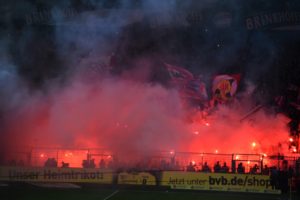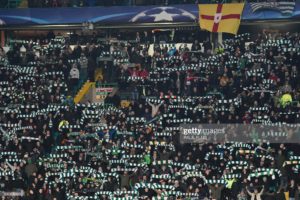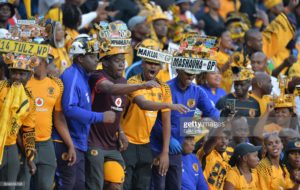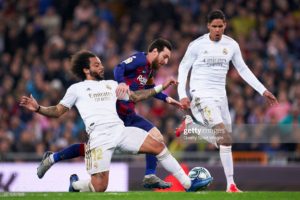Football Rivalry: Different evolutions in Scotland, South Africa and Spain
“I was married to a Celtic fan, it didn’t work out,” said David Edgar, co-producer of the hugely popular Rangers podcast Heart and Hand, “on Old Firm day she had to go and stay at her mother’s. The idea of watching the game together, just forget it.
“My daughter has come home with a Celtic supporter before and I tried very, very hard to subtly let her know that this isn’t the one. If I’m putting money towards the upkeep of this child, they must be a Rangers fan.”
Edgar, alongside his co-host Martyn Ramsay, is an intelligent, insightful and politely-spoken fan who makes such comments without hesitation due to several decades of exposure to the ferocious Old Firm rivalry between Rangers and Celtic.
If it was not clear already, football rivalry runs deep. In certain cities or countries, a perfect storm of circumstances and one-off events can cause them to trickle into all facets of life.
When rivalries play into decisions on love interests, children or which colour pool table you would be willing to play on, the often-overused comparison between religion and football fandom suddenly seems worthy indeed.

Having spent time in Argentina, I can testify that ‘where are you from?’ will only arrive after clearing up your alignment to either Boca Juniors or River Plate.
Similarly in Egypt, home to what is widely regarded as the world’s most violent football rivalry, the main differentiator between people is not based on religion, appearance or personality, but rather their allegiance to Al-Ahly or Zamalek.
In Glasgow, all it takes is a glance at someone’s trainers. A flash of green will lead you to a Celtic fan, while blue and red could only be worn by a follower of Rangers amid a rivalry which is constantly on display.
In a handful of places, two opposing sets of fans have garnered such intense hatred for one another that their rivalry achieves global notoriety, with proxy warfare taking place on the pitch.
The rarity of such disdain in a sporting scenario is what makes rivalry one of the most romanticised elements in football.
As the most prominent examples are few and far between, each flaunting their own unique histories, characteristics and backstories, a deeper look into three of the world’s most coveted seems a fitting way to explore a fascinating aspect of football.
Leading voices from around the globe have therefore been drafted in to share their stories and insight on legendary rivalries in Scotland, South Africa and Spain.
The Old Firm Derby
Celtic was founded in 1887 by Brother Walfrid as a medium to raise money for Catholic school children who were being tempted to protestant soup kitchens.
The native protestant Scots were concerned by Celtic’s early success, sharpening support for Glasgow Rangers as a means to quell the domination of what they saw as Catholic ‘Irishmen’.
Many of the foundations were laid there and then for the rivalry we see today which primarily intersects religion, political ideologies and unionism.

Much of the discrimination against Irish Catholics has subsided since, but just like any great drama; twists and turns along the way have kept the fire burning for well over a century.
David Edgar of Heart and Hand podcast said: “On Old Firm day you want to gather with your Rangers mates, when you go in there’ll be a lot of things sung by each set of supporters, there’ll be antagonism.
“The noise and intensity we actually take for granted during the game but when I take my other friends it really does take their breath away.”
Co-host Martyn Ramsay added: “You see people who should know better walking the wrong way and they get their shirts and scarves taken off them and burned.
“It’s such a short, combustible, antagonising game – the elements are the same all over the world but the Old Firm has such a history that they’re not allowed to just have a normal football rivalry.”
That history is laden with defining moments which have played an equally important role in developing the rivalry as the origins themselves.
With the Protestant and Catholic divide at the epicentre of the Old Firm rivalry and Rangers only lifting their ban on signing Catholic players as late as 1989, it was the signing concerned which both men unquestionably cited as the key moment in the timeline.
Former Celtic poster-boy Maurice Johnstone made the unthinkable switch from Parkhead to Ibrox after two years in France, making an instant impact.
Edgar said: “Growing up, it didn’t occur to anybody that an ex-Celtic player could play for Rangers, it was beyond science-fiction.
“He scored an injury time winner against them in his first Old Firm match at Ibrox and the bedlam that day was something to behold.
“I remember being thrown about 15-feet in the air by Rangers fans and I could see the utter horror on the face of Celtic supporters. It’s bad enough losing the derby, but him, they couldn’t believe he was doing it.”
As well as a match-up of history, wide-ranging opposition and fan violence, The Old Firm is a cold war of identity which continues simmering after the final whistle blows.
With Rangers sporting blue and red, flying the Union Jack at their home ground and green for Celtic who take pride in their Irish Catholic roots, their distinctive colours become an important part of daily life.
Ramsay said: “We are both men in our 40s with many degrees between us and there won’t be any green in my house. When it comes to interior design conversations about wallpaper or anything else, not happening!”
Edgar added: “In an out-and-out Rangers pub it would always be a blue pool table, there won’t be anything green. I’m 43, I’m fairly sensible and I don’t own any green clothing or anything like that, it would never occur to me to do it.”
The ferocious, electric tone at the stadiums are right on the precipice of enjoyment for the players involved. Rangers’ Ally McCoist famously netted 27 times in the fixture, while Ian Wright, who spent a short time at Celtic, failed to embrace what he described as a ‘vile atmosphere’.
However, it is precisely this which has allowed the rivalry to consistently punch above its weight in global terms.
Even when domestic Scottish football has slid further down the page of relevance, The Old Firm derby continues to top many people’s lists as the most revered football rivalry in the world.
The Soweto Derby
South Africa’s leading derby between Orlando Pirates and Kaizer Chiefs is certainly an anomaly in the realm of football rivalry, given it is one of the only examples where sworn enemies have successfully put their differences aside.
This being the case, the nature of the rivalry is appropriately split across two distinct eras.
The early days of the Soweto Derby were ferocious as the formation of Kaizer Chiefs was an incredible defining moment in itself. When former Pirates forward Kaizer Motaung rejected the political fighting at his old club, he formed a breakaway side under his own name in the same Johannesburg township of Soweto.
As South African football journalist Lorenz Köhler explains: “The rivalry had life or death connotations because it split a township.
“In townships all people had was football, that was their pride, entertainment and life, all they had was sport to keep them happy and entertained.”
As previously stated, the right ingredients in a given scenario can be the kindling to ignite a rivalry of hatred and violence – South Africa in the 1970s and 1980s was certainly that.
Köhler said: “South Africa’s political landscape at the time was divided, angry, resentful, violent, it was everything to do with what the Apartheid regime did to people’s psyche.
“A township of violent people with a destroyed psyche from oppression and violence leads to ‘ok, your team beat me so I am going to beat you to death’.”
Fans quite literally killed each other as a result of the fixture, as well as three separate stampedes on raucous derby days claiming the lives of dozens more.
While the political landscape provided the perfect backdrop to light a fire under the opposing fans’ relationship, the arrival of the South African liberation movement was the water which began to calm the flames.

The prospect of black liberation suddenly put the ‘life or death’ aspect of Soweto football into perspective, providing an alternative avenue for people to channel their passion.
Köhler said: “Nelson Mandela always preached that sport is a unifying factor for our country and it is the only way that we are going to move on into a different space.
“Portraying that to those two super-clubs was the quickest way to show that ‘this is your brother, we need to love each other and enjoy life and this is the only way things will get better’.”
With that, the Soweto Derby embarked on its second era, one of fraternity and celebration rather than violence and resentment.
While the hatred is still there in many respects, it is rarely seen on derby day which has unquestionably caused the rivalry to lose its cutting edge.
Köhler describes the atmosphere as joyous and euphoric, as if the national team was playing. Although the Soweto derby is no longer one of the most bitter, it represents a rare occasion where a happy ending lay in wait for both sets of fans.
El Clasico
The rivalry between Real Madrid and Barcelona, despite being separated by over 600km, is one of the most famous on Earth.
Known simply as ‘The Classic’, it might initially seem that the rivalry is built on the fact that the two sides are by far and away the most successful clubs in Spain.
With 34 La Liga titles for Real Madrid and 26 for Barcelona, mutually exclusive success certainly plays a part, although deep-seated political differences are also a huge factor, as in the Old Firm Derby.

As La Liga journalist and commentator Nicolai Lisberg explains: “We have to start talking politics when we talk El Clasico.
“The general story is that Madrid is the team of the government, the former dictator and the king, whereas Barcelona is the team of the Catalan people.”
Such differences were brought back into the public eye in recent years with the unsuccessful quest for Catalan independence making headlines across the continent.
Again, much like Celtic and Rangers, the two sides try to establish differences wherever possible. While Madrid pride themselves on being ‘Galacticos’ who consistently buy Europe’s premier talent, Barcelona nurture a homegrown image thanks to their famed La Masia academy.
Although the differences between the sides are obvious, defining moments like the 1943 Copa del Generalismo took El Clasico to the next level.
Barcelona won the semi-final first-leg 3-0 at home. On the return leg in Madrid, bottles and coins were hurled at Barca’s players in one of the most hostile atmospheres imaginable.
Lisberg added: “Madrid end up winning the match 11-1 and qualifying for the final, this is when it all began because this is the first match which has the element of scandal and controversy between the two teams.”
When it comes to objects thrown onto the pitch, the incident where former Barcelona player Luis Figo saw a pig’s head land next to him at the Camp Nou in his first El Clasico as a Madrid player has rightly gone down in history as a symbol of the division between the sides.
However, as visiting Spanish fans are often consigned to ‘Row Z’ in miniscule quantities, the lack of away culture in La Liga means the extent of the rivalry is barely felt in the city or the stadium.
This holds El Clasico back in terms of opposing fan relationships and camaraderie when compared to the Cairo derby or the Old Firm which is virtually an all-out war in the stands.
In many ways, this renders El Clasico as the neutral’s derby. The derby for spectators who want to see sensational football with ‘top dog’ status on the line.
The stakes are still astronomical, but with fans rarely coming together to face-off in person it will always lack that element of battle as enjoyed by some of the world’s other great examples.
Still, when matters on the pitch have flaunted battles like Lionel Messi versus Cristiano Ronaldo and Jose Mourinho versus Pep Guardiola, it is no wonder El Clasico is one of the most watched sporting events in the world.